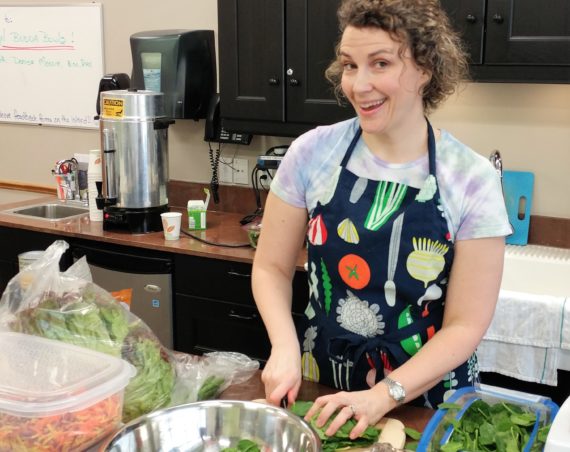Heather Johnston is a Certified Small Animal Massage Practitioner who provides dog massages at Flow Canine, based in Toronto, Ontario. Her introduction to the benefits of canine rehabilitation arose from a serious neurological issue experienced by her 6-year-old Pointer, Blue. This issue following surgery was treated with regular exercise and support, enabling Blue to gain full mobility.
We were so interested to learn from Heather’s experience as an animal wellness practitioner, the health benefits of a canine massage, her favorite types of foods for keeping her pets healthy and what you can do to be preventative to keep your pup healthy.
WEHL: What’s your personal philosophy on dog wellness?
HJ: Over time I’ve come to understand dog wellness in a whole new way. Our dogs give us so much and ask so very little, but to live long and healthy lives they need balance. They need great nutrition, they need an environment free of toxic elements, they need the right kind of exercise – both mental and physical. They need community. In short – they are just like us.

WEHL: Why did you want to start Flow Canine?
HJ: I was in a career transition. I knew I wanted work that allowed me to give back and I wanted to do something that brought me joy. When I put it all together, working with dogs seemed an obvious solution. I reflected on how much a canine massage therapist had helped my dog and decided that was the direction I would take. I researched all the available options for training and settled on an accredited program in Washington State with the Northwest School of Animal Massage.
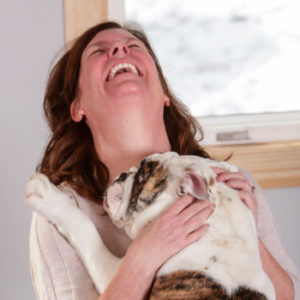 WEHL: Please tell us a little about animal wellness and what to expect from a dog massage?
WEHL: Please tell us a little about animal wellness and what to expect from a dog massage?
HJ: Canine massage is a great modality to help keep your pup in tip top shape. It’s especially beneficial for senior dogs or those recovering from illness or injury. Massage can also help dogs suffering from anxiety or other emotional trauma. Most dogs take to massage in 2-3 sessions but it looks different than human massage. Often a dog will stand up, walk around, or grab a toy in the middle of the session. My approach is to respect the dog and give them the time/space to be comfortable and get the most benefit from the session. I ask the dog’s guardian to be on hand to help in gentle handling and encouragement of the dog during the session. Having the guardian on hand helps the dog relax more easily.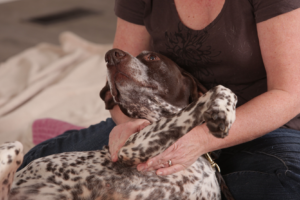
WEHL: Are there different types of dog massage?
HJ: I think of canine massage in 3 groups: Maintenance, Recovery and Performance. Recovery is focused on a specific injury site and generally overlaps a little with physical therapy. Performance is used for canine athletes before and after events. Maintenance is the focus of my practice. It’s a whole body approach that gently works to soften, release and gently stretch soft tissues resulting in an overall state of homeostasis and well-being.
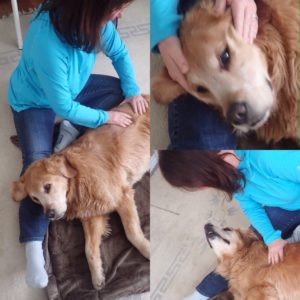 WEHL: Does the dog owner need to have anything available for their first massage?
WEHL: Does the dog owner need to have anything available for their first massage?
HJ: I usually work on the floor and bring along a blanket. If the dog has a favourite bed or prefers the couch I can work with that too. Sometimes treats can get in the way of relaxation, especially for those super-food motivated clients. I try to do without but will use treats (with the guardian’s permission) if I need to get them in a certain position.
WEHL: When’s the best time to get a massage for your dog?
HJ: Varies by dog, but generally after all the other needs (food, potty, exercise) are out of the way and they are ready to be restful. Dogs sleep 12-14 hours a day so there are generally a few good windows throughout the day that work.
WEHL: What should you do with your dog after the massage? Go for a walk? Or stay home and rest?
HJ: Gentle exercise after massage is just fine, but I find generally most dogs have a long restful sleep after a treatment.
WEHL: Are there any common problems that you see with dogs? 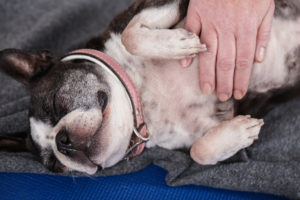
HJ: Dogs come with so many body types, and some of those are prone to chronic issues e.g. the long back of a dachshund or heavy musculature of the bulldog. There are also hereditary issues like hip dysplasia or common injuries due to over-exertion e.g. ACL tears. However the most common issue I see in my practice is mobility limited by osteoarthritis or poorly healed injury. Keeping a dog at perfect weight, and including a joint health supplement early in the aging process can help prevent or delay the onset of age related mobility issues.
WEHL: Can you do massages on dogs with no symptoms?
HJ: Absolutely! Massage makes just about every being feel better – human, dog, cat, bird … Through massage there is a lovely release of serotonin which positively affects many of the body’s systems including mood.
WEHL: Are there any supplements or foods that you recommend giving your dog to keep them healthy?
HJ: I once believed that a dog could live a long and healthy life eating a high quality kibble, but my perspective is changing. There is no doubt that many dogs do just fine, but I think they can do better eating unprocessed food. I am now feeding a raw diet and supplementing my senior with a joint supplement and fatty acids. I’ve just started my 10 week old puppy on raw and am adding a vitamin supplement. For guardians interested in feeding raw I’d recommend finding a Vet that is open to the idea and has some nutrition knowledge. Your pet is best served when you are working in partnership with your Vet to keep them healthy.
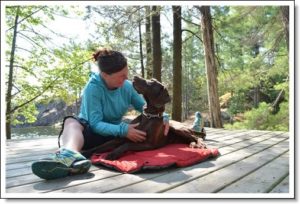
WEHL: What are some other things pet owners can to do be preventative?
HJ: It’s very important to keep up regular check ups and make note of changes in activity, eating, and mood. Major shifts in any of these factors can be a sign that your pet is experiencing pain or illness. Take advantage of your Veterinarian’s wellness programs and ensure you dog gets high quality food and appropriate supplements for their age/stage. Think about exercising your dog’s body AND mind. Build in nosework or training into your daily routine. Make sure the physical activity respects your dog’s body e.g. long runs on hard pavement or too much fetch or rowdy dog park play can cause injuries. Last thing … please get your dog a harness. Neck collars are fine for show, but once tied to a leash they become a potential source of injury of the cervical spine, and other structures in the neck.
Connect with Heather Johnston and Flow Canine:
- Web: www.flowcanine.com
- Email: [email protected]
- Phone: (905) 301-4064
We invite you to join our all-in-one healthy lifestyle app at Wehl.com!


